The mummies of Eastern Central Asia (hereafter ECA) first entered my consciousness in the summer of 1988. I had heard about them in the 1970s, but until I came face to face with them, I did not have a sense of their enormous importance for the study of Eurasian prehistory and history. I had been to the regional museum in Ürümchi many times before, but a visit in 1988 left me stunned by the newly opened exhibition of Bronze Age and Early Iron Age mummies.
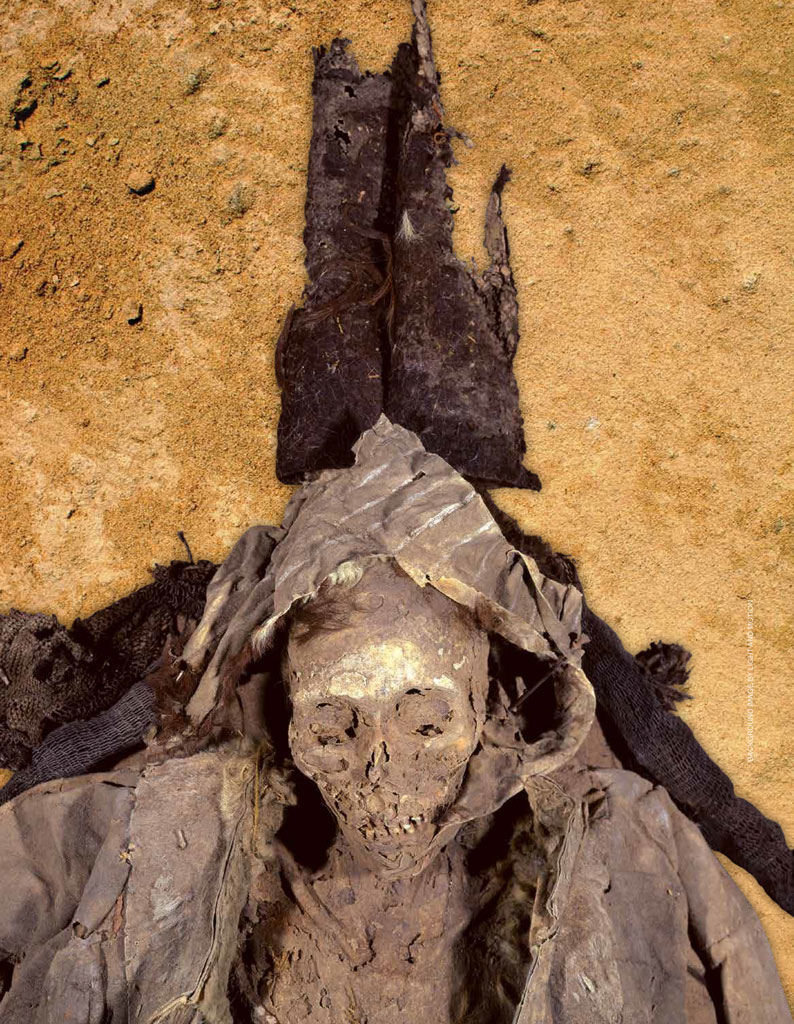
Were the Mummies Real?
Having passed through the black curtains that hung from the top of the door, I was somewhat suspicious, because the mummies looked too good to be true. The fact that they had light hair, fair skin, long noses, deepset eyes, and thin lips was also cause for pause. I thought that the mummies were part of an elaborate hoax perpetrated to drum up tourism. Yet the labels claimed the mummies dated to the 1st and 2nd millennia BCE. The artifacts accompanying them were also remarkably well preserved and, in many instances, technologically and culturally advanced. For example, the mummies had bronze, wheat, and the wheel before these appeared in the Central Plains of China, and their woolen textiles were of extraordinarily fine quality. The longer I stayed in that room full of mummies and carefully observed
them and their associated artifacts, my doubts gradually dissipated.
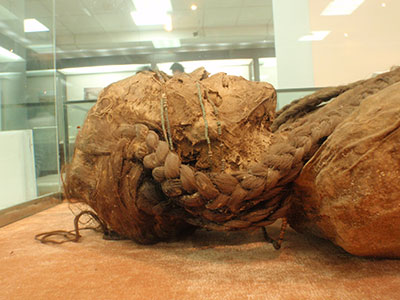
Returning to Penn to resume my teaching duties, I set aside thoughts of the mummies until the September 1991 discovery of Ötzi, the 5,300-year-old, perfectly preserved Iceman (see article in this issue). Spurred by this discovery, I began to organize an international investigation to carry out research on the mummies of ECA. In the summer of 1993, I led my first expedition to the Tarim Basin. That initial expedition was focused on ancient DNA studies, but later expeditions would delve into textiles, bronze and iron metallurgy, agriculture, and other aspects of the existence of the earliest inhabitants of the region. Nearly three decades after that fateful encounter in the summer of 1988, I am still actively engaged in investigations on the Tarim mummies. To use a Chinese expression, the mummies of ECA and I “youyuan” (have an affinity).
Bodies Preserved in Dry, Cold Conditions
The human remains that I discuss here are not actually mummies, but rather desiccated corpses. Their uncanny state of preservation is not due to any artificial means—such as we find with the mummies of Egypt—but to the extreme aridity and saline soils of the environment. Severely cold winters also played a significant role in arresting the processes of putrefaction and decomposition of the human remains. The mummies are found in cemeteries located along the southern and eastern edges of the Taklamakan (one of the world’s largest and driest deserts), which sits in the center of the Tarim Basin.
The Tarim Basin is one of the most remote (far from oceans and seas along whose littorals early humans travelled) and last populated places on Earth. During the Paleolithic and Neolithic periods in ECA (before 2000 BCE), there is no evidence of permanent settlement in the Tarim Basin. From the Bronze Age (in ECA, starting around 2000 BCE) onward, however, the region was a key locus of interaction between western and eastern Eurasia. Hundreds of mummies have been recovered from the Tarim Basin, some of which I describe here.

The Beauty of Loulan
Loulan is the fabled city near the vanished Lop Nor (“Lop Lake”) that lay in the northeastern corner of the Tarim Basin. The Beauty of Loulan is a comely woman who was among the first mummies to be discovered in the region. She has been dated to about 1800 BCE. Shortly after she was found in the late 1970s, she became a cause célèbre among the local Turkic-speaking Uyghur people who considered her their ancestor, which they believed gave them a prior claim to the region over the Han Chinese, who arrived about 2,000 years later.
Unfortunately, the Uyghurs themselves did not arrive in the Tarim Basin until nearly a millennium after the Han Chinese. Thus, the Beauty of Loulan embodies one of the many mysteries about the mummies, namely, if she were neither a Sinitic-speaking Chinese nor a Turkic-speaking Uyghur, what language did she speak? Evidence exists indicating she may well have spoken Tocharian, the second oldest (after Hittite) Indo-European language.
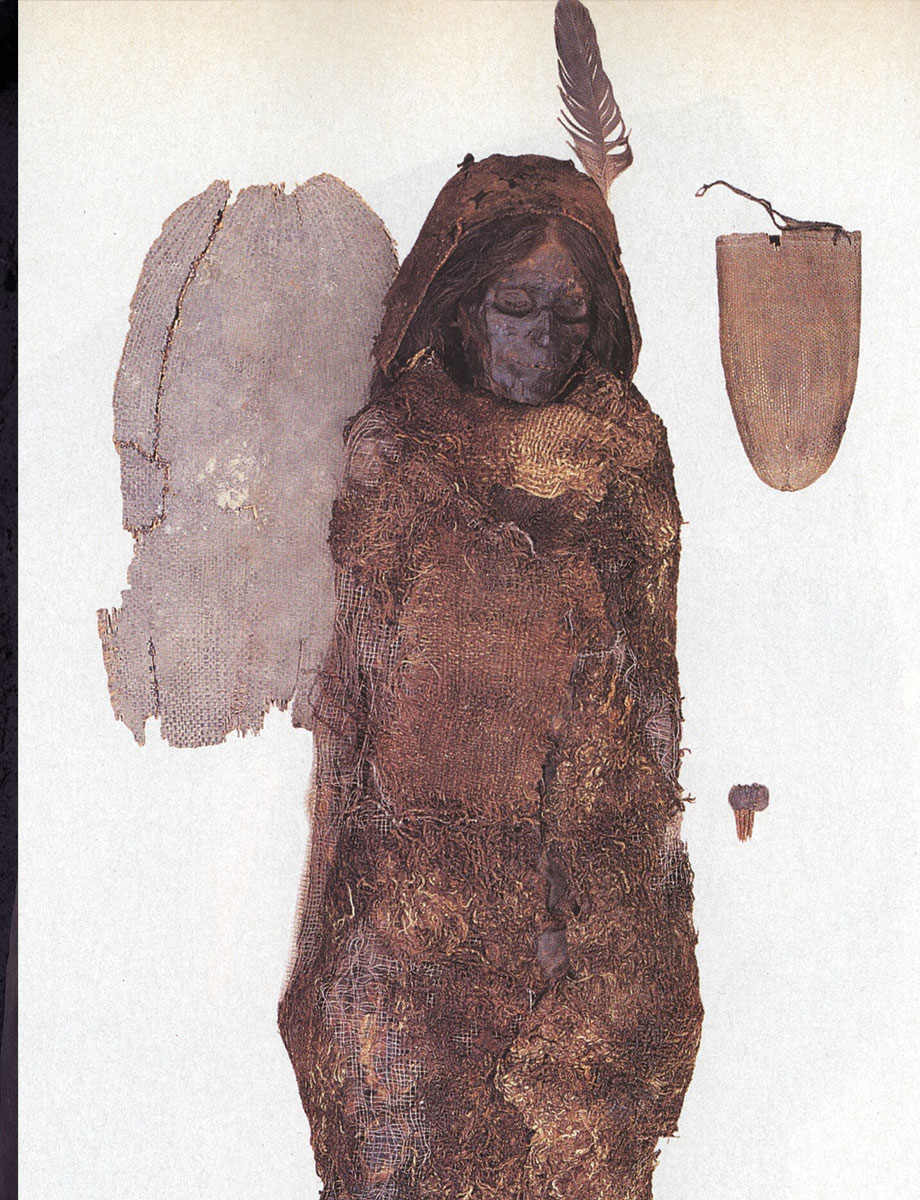

The Beauty of Xiaohe
One of the more recently unearthed mummies, the Beauty of Xiaohe, was recovered from Ördek’s Necropolis, far out in the desert at Small River Cemetery No. 5 along the mostly dried up Xiaohe (“Small River”), during excavations in the early 21st century. When the cover of her boat coffin was removed, she was found wearing a magnificent white hat. The Beauty of Xiaohe dates to around the same period and to a similar culture as the Beauty of Loulan. Xiaohe is located roughly 120 kilometers to the west-south-west of Loulan. (For more on the Beauty of Xiaohe and other mummies featured in the Penn Museum’s Secrets of the Silk Road exhibition in 2011, see special issue of Expedition 52.3.)
Chärchän Man
Chärchän Man was recovered from a tomb near the village of Zaghunluq in Qiemo County, in the central portion of the southern edge of the Tarim Basin. The tomb is situated on a plateau with extremely saline soil, which enabled excellent preservation of textiles from the extensive cemetery. This site is considerably more recent than the two discussed above and dates to around 600 BCE.
By this time, colorful dyes were being used in textile production, allowing for a breathtaking variety of garments. This includes the burgundy clothing worn by Chärchän Man and his two wives. The robe on the main wife is so fine that it is hard to imagine how their weaving technology could have reached such an advanced stage by that time. In a small grave next to the main tomb, a baby was found wearing a shroud of the same burgundy color and a blue cashmere cap.



Yingpan Man
Yingpan is located along an ancient caravan trail to the west of Turfan. Judging from his clothing and accessories, Yingpan Man must have been fabulously wealthy and is surely to be counted among the best dressed men of antiquity. Nearly 6’ 6” tall, Yingpan Man’s face is covered by a white mask with a strip of gold foil across the forehead. Yingpan Man’s amazing outfit, with its Greco-Roman motifs (including putti or cherubs and bulls with laurel wreaths around their midsection) and extravagant embroidery, marks him as a man of far-reaching connections.
Although his seriously decomposed body no longer lies within its sartorial shell, we know from earlier descriptions that he was a Caucasoid with brown hair. Considering his riches, international aura, and the strategic trading spot where he was buried, it is possible that Yingpan Man was a Sogdian merchant from a group of Middle Iranian people who were traders par excellence throughout Eurasia.
The Witches of Subeshi
The most intriguing mummies in ECA may be the “witches” of Subeshi, who wear very tall, pointed black hats that resemble the iconic headgear of their sisters in medieval Europe. Subeshi, dated to between the 4th and 2nd centuries BCE, is located in a high gorge just to the east of the important city of Turfan.
Historian and author Adrienne Mayor has recently suggested that the single heavy glove worn by one of the female mummies may indicate that she hunted with a raptor such as a golden eagle. A number of impressive male mummies have also been excavated at Subeshi, including a man who wears a felt helmet and another man whose chest has been stitched up with horse hair in what must be one of the oldest (4th century BCE) examples of surgery in the world.
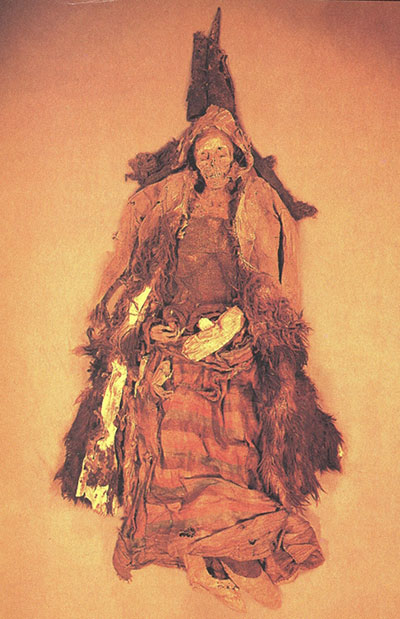
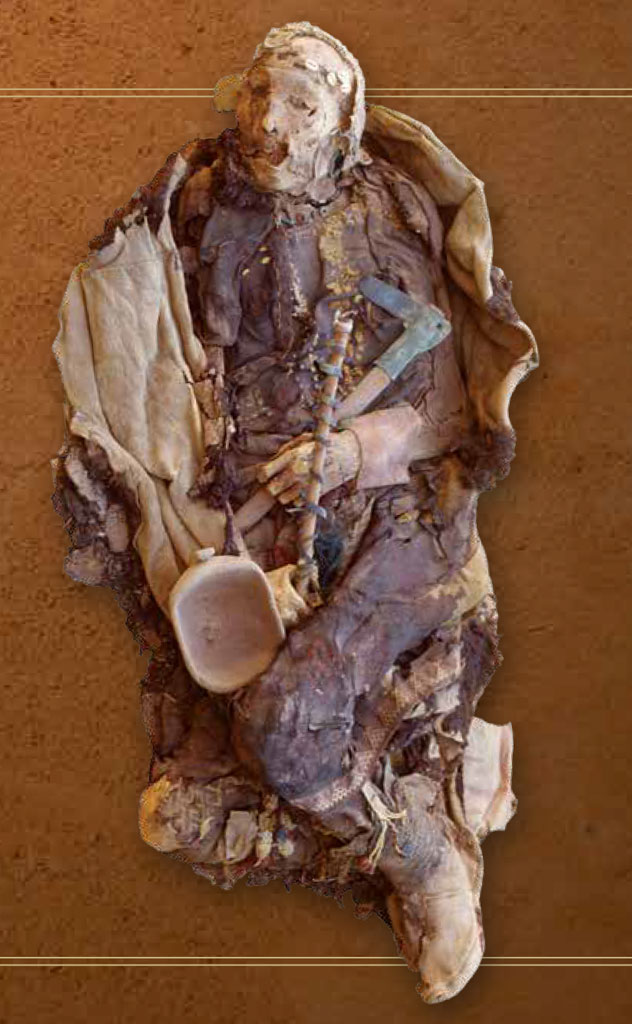
The Shaman of Yanghai
Going west through the Toyuq Gorge, where the site of Subeshi is located, and entering the flat, rocky desert land below, one comes to the vast series of cemeteries at Yanghai, which date to around 900 BCE. Among the mummies from Yanghai are a small boy whose chin is tucked under on his chest and a shaman-like figure with bells on his boots, who is smothered in cannabis.
Another man from Yanghai had a well-preserved harp by his side. Also recovered from Yanghai is the world’s first wooden leg prosthesis and many other wondrous finds, all of which have been described in the full excavation report by archeologist Lü Enguo.
The Man from Hami with a Dozen Hats
A man found at the Qizilchoqa cemetery near Wupu (“Fifth Burg”), about 60 km to the west of Hami (Qumul), appeared to have had an obsession with fancy, distinctive hats. Among the marvelous collection buried with him are a beret made of the world’s first nålebinding
(a technique like crocheting) and a Phrygian-style cap made of thick brown felt with striking white ornamental stitching. Also from this site are plaids employing the same weave (diagonal twill) as plaids from Celtic sites in Europe dating to around the same period (ca. 1000 BCE).
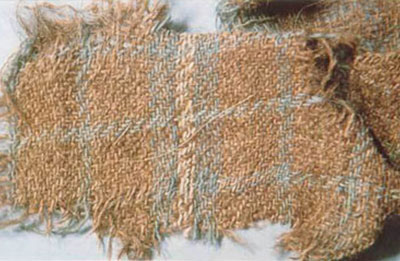

Research Continues
The early inhabitants of Eastern Central Asia did not belong to a single genetic and linguistic stock, nor did they come from a single source. They entered the Tarim Basin at different times and arrived from different directions— north, northwest, west, and southwest in the earlier periods; northeast, east, southeast, and south during later periods (though they also continued to come from the north, northwest, west, and southwest as well). Our research on the mummies of the Tarim Basin is still at its beginning stages. Many fascinating questions remain to be answered, yet we have already learned much about these prehistoric denizens who represent one of the most important sources of information about the development of Bronze Age and Early Iron Age civilization.
Victor H. Mair, PH.D. is Professor of Chinese Language and Literature in the Department of East Asian Languages and Civilizations at the University of Pennsylvania. He was curator of the 2011 Penn Museum exhibition Secrets of the Silk Road.
For Further Reading
Museum Publications, 1998.
Mallory, J.P., and V.H. Mair. The Tarim Mummies: Ancient China and the Mystery of the Earliest Peoples from the West. London: Thames & Hudson, 2000.
Mair, V.H. “The Mummies of East Central Asia.” Expedition 52.3 (Winter 2010): 23-32.
Mair, V.H., ed. Secrets of the Silk Road: An Exhibition of Discoveries from the Xinjiang Uyghur Autonomous Region, China. Santa Ana, California: Bowers Museum, 2010.
